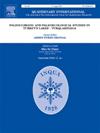追踪小米向南的传播:来自中国中部汉江流域中部新石器时代晚期寨子山遗址的考古植物学证据
IF 1.8
3区 地球科学
Q3 GEOGRAPHY, PHYSICAL
引用次数: 0
摘要
小米向南传播是当前中国考古研究的热点之一。小米进入江汉平原可能有三条路线,其中连接南阳盆地和江汉平原的汉江走廊尤为重要。然而,这一普遍的假设仍然需要强有力的考古学证据来支持。在位于汉江走廊南端的寨子山遗址,浮选分析鉴定出水稻(Oryza sativa)、粟(Setaria italica)和黍(Panicum miliaceum),以及14种非作物遗迹。分析表明,在幼子岭文化时期(5800 ~ 5300 BP),谷子在江汉平原附近已经存在,但在作物组合中并不突出。然而,在屈家岭文化时期(5300-4500 BP),其重要性有所增加,尽管水稻仍占主导地位。在石家河文化时期(距今4500-4200年),小米的重要性可能进一步提高。有子岭文化时期寨子山遗址发现的小米,有力地支持了不迟于5300年前汉江走廊是小米向南传播路线的理论。此外,通过比较寨子山和屈家岭遗址的作物结构,我们发现自然和文化因素都促进了小米在农业系统中的重要性增加。此外,倾斜的地形可能促使古代人类种植更多的谷子。该研究对于探索谷子南下传播的时空过程、谷子对长江中游地区新石器时代作物结构的影响,以及自然条件、考古文化与史前农业之间的复杂关系具有重要意义。本文章由计算机程序翻译,如有差异,请以英文原文为准。
Tracing the southward spread of Millets: Archaeobotanical evidence from the late Neolithic Zhaizishan site in the middle Han River valley, central China
The southward spread of millets is one of the current hotspots of Chinese archaeological research. The entry of millets into the Jianghan Plain likely followed three routes, with the Han River corridor, linking the Nanyang Basin to the Jianghan Plain, being particularly significant. However, this prevalent hypothesis still requires robust archaeobotanical evidence to support it. At the Zhaizishan site, located at the southern end of Han River corridor, flotation analysis identified rice (Oryza sativa), foxtail millet (Setaria italica) and broomcorn millet (Panicum miliaceum), along with 14 types of non-crop remains. The analysis indicated that during the Youziling culture period (5800–5300 BP), millets were already present near the Jianghan Plain but less prominent within the crop assemblage. However, its significance increased during the Qujialing culture period (5300–4500 BP), although rice continued to be dominant. During the Shijiahe culture period (4500–4200 BP), the importance of millets may have further increased. The discovery of millets at the Zhaizishan site during the Youziling culture period strongly supports the theory that the Han River corridor served as a route for the southward spread of millets, no later than 5300 years ago. In addition, by comparing crop structures at the Zhaizishan and Qujialing sites, we found that natural and cultural factors both contributed to the increasing importance of millets within the agricultural system. Additionally, the sloped terrain would have driven ancient humans to cultivate more millet. This study is of great significance for exploring the spatiotemporal processes of the southward spread of millets and the impacts of millets on the Neolithic crop structure in the middle Yangtze River region, as well as the complex relationships among the natural conditions, archaeological cultures, and prehistoric agriculture.
求助全文
通过发布文献求助,成功后即可免费获取论文全文。
去求助
来源期刊

Quaternary International
地学-地球科学综合
CiteScore
5.60
自引率
4.50%
发文量
336
审稿时长
3 months
期刊介绍:
Quaternary International is the official journal of the International Union for Quaternary Research. The objectives are to publish a high quality scientific journal under the auspices of the premier Quaternary association that reflects the interdisciplinary nature of INQUA and records recent advances in Quaternary science that appeal to a wide audience.
This series will encompass all the full spectrum of the physical and natural sciences that are commonly employed in solving Quaternary problems. The policy is to publish peer refereed collected research papers from symposia, workshops and meetings sponsored by INQUA. In addition, other organizations may request publication of their collected works pertaining to the Quaternary.
 求助内容:
求助内容: 应助结果提醒方式:
应助结果提醒方式:


